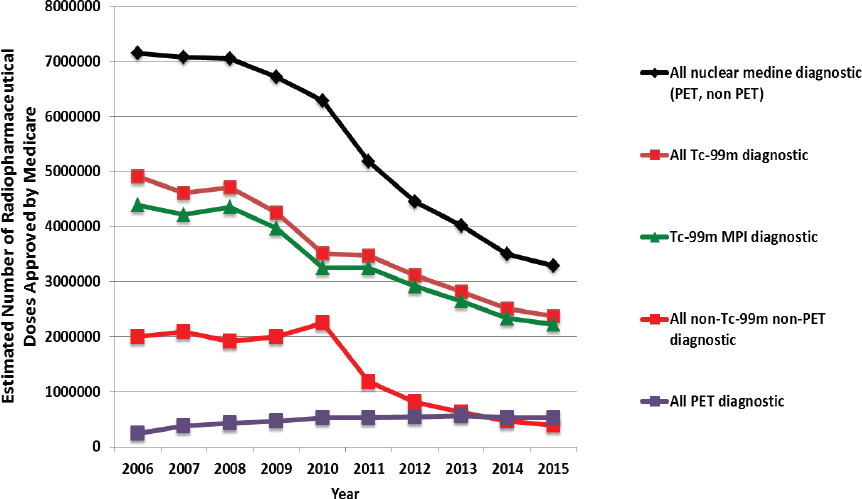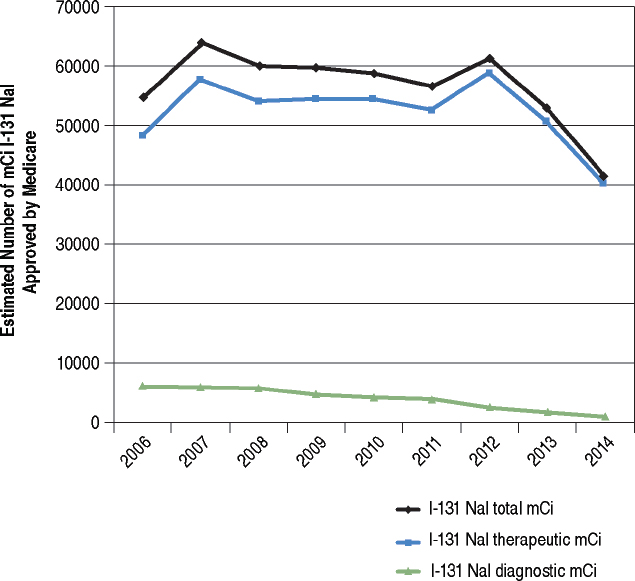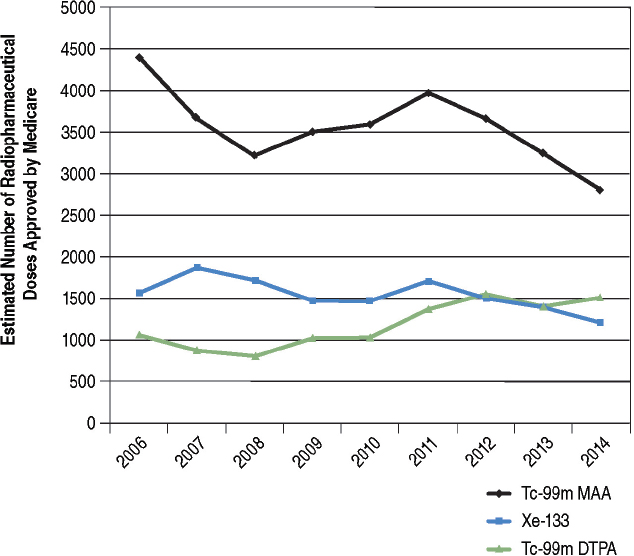2
Molybdenum-99/Technetium-99m in Nuclear Medicine
The decay product of molybdenum-99 (Mo-99), technetium-99m (Tc-99m), is used in about 80 percent of all nuclear medicine procedures worldwide. It is the isotope of choice for single-photon emission computed tomography (SPECT) because of its 140-keV gamma-ray emission, its convenient half-life of 6 hours, and availability in the form of Mo-99/Tc-99m generators.
DEMAND FOR MOLYBDENUM-99/TECHNETIUM-99M
The United States is the largest consumer of Tc-99m, carrying out 50 percent of all procedures that utilize Tc-99m worldwide, or approximately 40,000-50,000 procedures daily. Dr. Wolfgang Weber (Memorial Sloan Kettering) noted that in the United States, myocardial perfusion imaging for coronary artery disease dominates the overall demand for Tc-99m owing to the high prevalence of coronary artery disease and the relatively large amounts of Tc-99m needed to image for the disease. A second major application of Mo-99/Tc-99m is whole-body imaging for detection of bone metastases and to a lesser extent for benign bone diseases such as inflammation. Other applications include sentinel node imaging before surgery for breast cancer or melanoma, as well as for thyroid, lung, and renal imaging.
Utilization of Mo-99/Tc-99m has declined globally. The National Academies reported a 45 percent decline in Tc-99m utilization in the United States based on analysis of Medicare1 data for the period 2006-2014 (NASEM, 2016). The decline continued in 2015 based on more recent analysis (see Figure 2.1). Dr. Ourania Kosti (National Academies) noted that the decline started in 2006 or earlier, that is, before the 2009-2010 Mo-99 shortages, for reasons not attributable to supply disruptions. Several factors contributed to the decline, including changes in medical insurance reimbursement policies, increased preference for competing imaging modalities, widespread acceptance and further development of appropriate use criteria, radiation exposure concerns, and more efficient use of Tc-99m. According to the 2016 National Academies report, these factors are likely to continue to operate and result in further decline of Mo-99 demand. Indeed, articles have been published since the release of the 2016 NASEM report, indicating additional changes in medical insurance reimbursement policies related to medical imaging aiming to reduce medical costs.2 The 2016 National Academies report also noted a 25 percent decline
___________________
1 Medicare is the federal health insurance program in the United States for people 65 years of age and older and for those with permanent disabilities.
2 See, for example, http://www.modernhealthcare.com/article/20170826/NEWS/170829906 and http://www.dailypress.com/news/.

NOTE: CPT Copyright American Medical Association. All rights reserved. CPT is a registered trademark of the American Medical Association.
SOURCE: Courtesy of Dr. Kathryn Morton, University of Utah.
in I-131 and Xe-133 utilization (see Figures 2.2 and 2.3), medical isotopes that are co-produced with Mo-99 in research reactors and can be recovered for use in medical applications.
Dr. Weber noted that new camera systems that improve the resolution of Tc-99m images together with improved software for data analysis and multimodal imaging such as SPECT/computed tomography (CT) have the potential to increase the future demand for Mo-99/Tc-99m or at least keep the demand stable. However, he noted that development of new Tc-99m radiopharmaceuticals has been slow in the past two decades and therefore unlikely to contribute to increases in Tc-99m utilization in the near future. The most recent Tc-99m agent to be approved by the U.S. Food and Drug Administration was Tc-99m tilmanocept (Lymphoseek™) in 2013 (Agrawal et al., 2015). Most research and development in radiopharmaceuticals has focused primarily on positron emission tomography (PET) imaging agents owing to their higher sensitivity and easier quantification of PET signals.
The Organisation for Economic Co-operation and Development (OECD)’s Nuclear Energy Agency (NEA) considers that current
- Global demand for Mo-99 is 9,000 six-day Ci/week (2015 estimate), and
- Demand growth rate for Mo-99 is 0.5 percent for mature markets (Europe, Japan, North America, Oceania, and South Korea) and 5 percent per year for developing markets (South America, Africa, and Asia) (2014 estimates).
Dr. Jin Du (China Isotope & Radiation Corporation) confirmed that in China, Mo-99/Tc-99m utilization has increased by 5 percent during the past 5 years. He noted that the Chinese Society of Nuclear Medicine is focusing on efforts to develop nuclear medicine programs in the country and on training nuclear medicine physicians. These investments in nuclear medicine programs will likely result in further growth of Mo-99 demand in China.


NOTE: Most of Xe-133 studies are carried out in conjunction with Tc-99m macroaggregated albumin (MAA) lung perfusion imaging for the diagnosis of pulmonary embolism. The other ventilation agent in wide use in the United States is Tc-99m pentatate (DTPA) aerosol (an off-label use of an FDA-approved agent for renal and brain imaging) (NASEM, 2016).
Apart from China, no other country represented at the symposium indicated a projected increase in Mo-99 demand in the near future.3
NUCLEAR MEDICINE PROGRAM DEVELOPMENT
The IAEA has been tracking information related to trends in nuclear medicine worldwide and has reported considerable variability across countries in infrastructure, technology, and educational resources for implementing nuclear medicine practice, training, and research. Mr. Rodolfo Nuñez-Miller (IAEA) noted that Africa is the continent with the largest disparities in relation to nuclear medicine applications: of Africa’s 54 countries only half have nuclear medicine programs.
The IAEA helps Member States develop, expand, and operate nuclear medicine facilities. It has focused on providing assistance for developing nuclear medicine programs in low- and medium-income countries to help overcome several challenges these countries face related to
- Training a multidisciplinary team of professionals, including physicians, medical physicists, radiographers, and radiochemists;
- Assessing the impact of introducing novel high-cost health technologies and their sustainability;
- Purchasing and utilizing high-cost equipment for nuclear medicine imaging and laboratory equipment for the nuclear pharmacy and providing for quality control;
- Managing potential increases in healthcare costs; and
- Complying with international standards where there is a lack of adequate infrastructure, quality assurance culture, and qualified human resources to do so.
The IAEA’s support for nuclear medicine programs is provided through technical cooperation projects. For example, the IAEA may assist Member States in designing nuclear medicine expansion projects, capacity building, fellowship training, providing equipment and supplies, and auditing quality management. Mr. Nuñez-Miller noted that expansion or development of nuclear medicine programs requires strong and committed support from the national government. He also noted that development of nuclear medicine programs takes a long time, a minimum 4 years. This lag time from initiating the development of nuclear medicine programs to offering nuclear medicine tests needs to be considered when projecting Mo-99/Tc-99m utilization trends in emerging markets.
___________________
3 Mo-99 demand may be increasing in other developing and developed countries not represented at the symposium. The countries represented at the symposium are currently producing Mo-99 or have plans to produce Mo-99. Countries with no current or planned Mo-99 production were not represented at the symposium.




